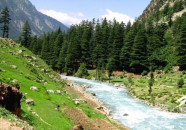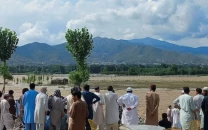Sukkur Barrage sustains super flood
Irrigation officials on Saturday warned communities that the water levels at the Guddu and Sukkur barrages had risen.

By Saturday evening, 1,100,000 cusecs of water was passing through Guddu Barrage. Irrigation sources said Guddu Barrage had remained steady for about 24 hours at 962,000 cusecs and that they had expected that the level would now recede. They said the probable reason for the rise was the inflow of rainwater from the hilly areas of Balochistan which was adding to the pressure on the River Indus. If the situation continues, Guddu Barrage might reach the 1,200,000-cusec mark, they said. Near Guddu, two villages were inundated and Machko Town, populated by over 20,000 people, was being evacuated. At Sukkur Barrage, 980,000 cusecs were recorded and the water level was said to be constantly rising. Upstream flow was recorded at 980,000 cusecs and downstream flow was 953,000 cusecs.
The breach in the Tori bund near Kandhkot extended to 80 feet, submerging 16 villages of the kaccha area as a consequence. The bund serves as a primary protective wall and had earlier developed a 50-feet-wide breach due to pressure from River Indus. The army personnel were busy evacuating villagers as well as trying to plug the breach with the help of local residents.
Sensing danger, the district administration has issued a warning to residents of four more towns and a village to evacuate. These towns house as many as 80,000 people and the Indus Highway between Kandhkot and Kashmore has been sealed. A large protective dyke near Hamid Malik village has also developed cracks. Villagers with support from army personnel were trying to repair the cracks but should a breach develop if they fail the towns of Jacobabad, Shikarpur, Khanpur, Mian Sahib and Tangwani would be flooded.
Irrigation authorities have declared the twelfth and fifteenth mile of Kandhkot-Kashmore dyke as the most vulnerable and more troops have been deployed there. The rising water is pressurising Ghouspur-Milap dyke, which is currently shielding Badani Town from flooding.
Earlier, Jam Saifullah Dharejo, the provincial irrigation minister, admitted at a news conference that officials have deliberately breached the Ghouspur loop bund to lessen the pressure of floodwaters.
Clarifying the situation, he said that the Tori bund has developed a breach and the gushing waters inundated several villages. This forced the authorities to decrease the pressure on other bunds and barrages, by breaching the Ghouspur loop bund. Had we not taken this decision, Ghouspur and Karampur towns and other adjoining areas would have been at risk of inundation,” he claimed.
Disparity in barrage capacity figures
As the country copes with massive floods, figures released by several government departments about the capacities of different barrages do not match, leading to confusion about the maximum water discharges these structures are able to withstand.
The water and power ministry says that the Sukkur Barrage is designed to sustain a discharge of 1.5 million cusecs, while the Pakistan Meteorological Department puts it at 900,000 cusecs. Unexpectedly, the head of the National Disaster Management Authority (NDMA), Nadeem Ahmed, a retired lieutenant-general, says the design capacity of the barrage is 1.2 million cusecs.
The ministry claims that between Aug 10 and Aug 11, a water discharge between 600,000 and 700,000 cusecs will pass through the Kotri Barrage. The Met office put the figure for the same period between 6000,000 and 800,000 cusecs.
The flood commission wing of the federal water and power ministry says that the Taunsa Barrage can sustain a water discharge of 1.1 million cusecs while the Kotri Barrage can let 875, 000 cusecs of water pass through it.
But the Met office puts the design capacity of the barrage at 900,000 cusecs and the Kotri Barrage at 850,000 cusecs.
(WITH ADDITIONAL REPORTING BY ASIM AWAN IN ISLAMABAD)
Published in The Express Tribune, August 8th, 2010.



















COMMENTS
Comments are moderated and generally will be posted if they are on-topic and not abusive.
For more information, please see our Comments FAQ